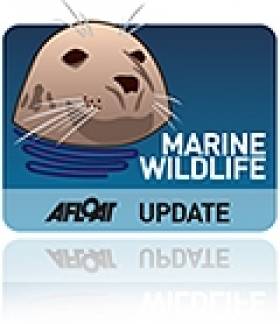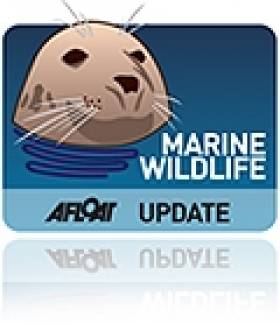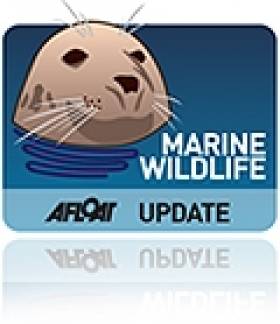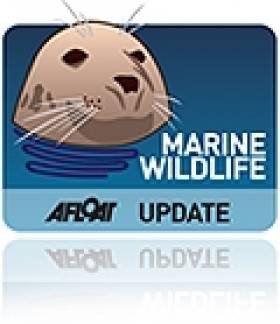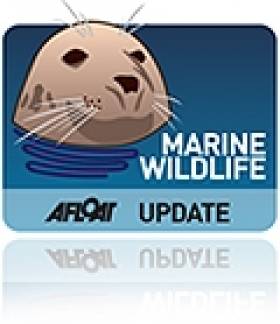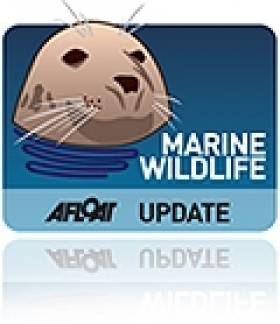Displaying items by tag: marine wildlife
Happy Outcome for Mayo's Stranded Minke Whale
#MARINE WILDLIFE - Conor McGuire and friends were taken by surprise when they came across a stranded minke whale in Clew Bay, Co Mayo - but thankfully this whale of a tale had a happy outcome.
As the Irish Whale and Dolphin Group (IWDG) reports, the group of friends videoed the scene as the 4-5m young minke whale attempted to free itself from the shingle at the edge of the shore.
The IWDG commented: "Sometimes it is hard to avoid the temptation to jump in and get involved in coaxing the cetacean back into deeper water.
"But hats off to Conor and friends, who quite rightly gave the whale as much time as it needed to correct the situation."
According to the IWDG, such stranding often end in tragedy "as the animal becomes disorientated and stressed, so this record is particularly unusual."
The group also noted "with interest" that the event occurred just before the biggest earthquake ever recorded in the North West region.
As previously reported on Afloat.ie, the epicentre of the magnitude 4 quake was close to the Corrib Gas Field off Co Mayo.
The IWDG said it will be closely watching the region "to see if there is any spike in unusual stranding events that may be linked to this seismic activity".
#MARINE WILDLIFE - The Irish Whale and Dolphin Group (IWDG) has called for the extension of Ireland's pioneering whale and dolphin sanctuary throughout European coastal waters.
As the Clare Herald reports, the move comes on the 21st anniversary of the declaration of Irish waters as a sanctuary for cetaceans by then Taoiseach Charles Haughey - whose family gifted his yacht Celtic Mist to the IWDG to assist in its marine wildlife conservation work.
"The sanctuary declaration was unique in Europe and no EU member state had made such an unequivocal statement about the importance of their waters for cetaceans," said the IWDG's Brendan Price.
The sanctuary extends up to 200 nautical miles offshore, covering the Irish Exclusive Economic Zone, and in the two decades since its founding has prompted a greater awareness of and interest in the whales and dolphins that populate Ireland's waters.
The declaration "led to a clearer understanding of the responsibility Ireland had to cetaceans and their habitat including in offshore waters," added Price. "The sanctuary declaration was a precursor to action leading to protection in Irish waters and thus the IWDG considers the sanctuary declaration a success."
Price went on to outline the IWDG's vision for extending this sanctuary throughout European waters.
"There are a number of small marine protected areas in Europe for cetaceans, including harbour porpoise and bottlenose dolphins, and some international sanctuaries such as the Pelagos Sanctuary in the Mediterranean.
"These areas all have important roles to play but cetaceans are mobile marine species and travel large distances. Also, to gain public support for cetacean conservation it may require a larger, more simple concept."
The group intends to promote its proposals within the continent "and encourage like-minded people and organisations to lobby their own government to make such a clear and unequivocal statement on cetacean conservation".
Seal Heads Sicken Staff at Dingle Wildlife Sanctuary
#MARINE WILDLIFE - Staff at the Dingle Wildlife and Seal Sanctuary were subject this morning to the gruesome sight of two baby seal heads nailed to signs outside the facility.
According to the Irish Independent, the grisly scene was accompanied by a sign reading 'RIP Cull' in red paint, presumed to be a reference to local fishermen's urging for a reduction of seal numbers in the area.
Last year Afloat.ie reported on Kerry fishermen's call for a cull of the "overprotected" local grey seal population over claims that they eat up to 10kg of fish a day.
And earlier this year, fears were growing of an illegal cull of marine wildlife after a two seals were found dying from bullet wounds on Tramore Beach in Co Waterford.
"It was sickening," said the sanctuary's Ally McMillan of the incident. "I wanted to be sick when I saw them."
Gardaí in Dingle removed the seal heads and sign as part of their investigation.
Meanwhile, the Irish Examiner reports that animal rights group ARAN has put up a €5,000 reward for anyone with information leading to the arrest or conviction of those responsible for the killing.
“Animal abusers are cowards, and we’re hoping this reward will apprehend those responsible for this most sickening act of animal abuse,” said ARAN spokesman Stephan Wymore.
#MARINE WILDLIFE - The Department of Energy could be in beach of the EU habitats directive for licensing a seismic survey off the West coast without providing adequate protection for marine wildlife.
As The Irish Times reports, the Irish Whale and Dolphin Group (IWDG) has lodged a complaint with the European Commission and the Department of Energy over the survey licence.
Shell E&P Ireland Limited is scheduled to carry out the 3D seismic survey over the Corrib Gas Field off Co Mayo from today 1 June, as previously reported on Afloat.ie. Weather permitting, the survey would be completed around the middle of September.
The waters around Ireland are designated as a whale and dolphin sanctuary. According to the IWDG, 21 cetacean species have been recorded off the Mayo coast, including endangered species such as the northern right whale, fin whale and humpback whale.
Under the EU habitats directive, member states are mandated to establish strict protections for marine wildlife, which includes prohibiting “deliberate disturbance... particularly during the period of breeding, rearing, hibernation and migration”.
The Irish Times has more on the story HERE.
#MARINE WILDLIFE - Another humpback whale sighting off West Cork has been confirmed by the Irish Whale and Dolphin Group (IWDG) - and it could be a new arrival to these shores.
The humpback was encountered some seven miles southeast of Galley Head near Clonakilty Bay on Wednesday 16 May by local whale watch operator Colin Barnes.
A tell-tale series of three blows and a tail fluke were enough for Barnes to confirm the species, but unfortunately its identity could not be confirmed, which means it could be a newcomer to Irish waters or one of two humpbacks sighted in the same area in earl April, as previously reported on Afloat.ie.
"If it is a new animal, this will bring to 21 the number of recognisable humpbacks recorded to date in Irish waters," said IWDG sightings co-ordinator Pádraig Whooley, who noted with interest that while the group is concluding its field work in the seasonal feeding grounds around Cape Verde, there are "also humpbacks present at higher latitude feeding grounds".
Whooley commented at the time of the April sightings: "Why these two young humpbacks are here during spring, when years of data shows them to be absent in these months, is a mystery."
The IWDG has more on the story HERE.
#MARINE WILDLIFE - The East Coast of Ireland was treated to a rare sight yesterday morning with the spotting of a basking shark at Dun Laoghaire.
According to the Irish Whale and Dolphin Group (IWDG), the gentle giant was sighted by Ronan McLaughlin of the Naval Service vessel LE Ciara at the entrance to Dun Laoghaire Harbour - which may allow for the perfect opportunity to easily observe the visitor.
IWDG sightings co-ordinator Pádraig Whooley said: "So far 2012 has been another very good year for sightings of this 'honorary whale', with 78 validated sightings to date, almost all of which have come from the south and west coasts."
He added: "In recent years only between 1-5% of all basking shark sightings have been off the Irish East Coast, which is at odds with the fact that [the] nearby Isle of Man is considered to be one of the best sites to observe the planet’s second biggest shark species."
Basking sharks are protected under EU law, which makes it illegal to disturb or harass them.
As previously reported on Afloat.ie, the UK's Shark Trust has published a code of conduct for anyone encountering basking sharks in British or Irish waters this summer.
#MARINE WILDLIFE - The Irish Whale and Dolphin Group (IWDG) reports that two marine science students from the Galway-Mayo Institute of Technology (GMIT) have joined IWDG members on an eight-day transatlantic cetacean and bird survey on board the RV Celtic Explorer.
"The mid-Atlantic is rarely surveyed for marine mammals so the results of this survey will be a large contribution to our limited knowledge of the species richness and relative abundance in this region at this time of year," said the IWDG's Conor Ryan.
"Last year, we surveyed a similar route during the winter/late spring and encountered fin whales, sperm whales, bottlenose dolphins, striped dolphins, common dolphins and pilot whales."
Students Paddy O'Dwyer and Enda McKeogh are keeping a daily blog of the trip for those interested in following them across the Atlantic which can be read HERE.
Basking Sharks Return to British and Irish Waters
#MARINE WILDLIFE - The second largest fish in the sea is making its return to British and Irish waters - and experts are calling on the general public to report any sightings, as BBC News reports.
Basking sharks are a regular visitor to these climes, drawn to the warm waters of the Irish Sea rich in plankton that they scoop into their gaping metre-wide jaws.
"They're here for most of the summer," said Dr David Gibson, managing director of the National Marine Aquarium in Plymouth. "We're asking people to let us know whenever they see one of these fantastic animals."
People are also advised to "keep a respectful distance and enjoy the spectacle", as while the massive sharks are harmless, they are a protected species under EU law which makes it illegal to disturb or harass them.
For guidance, the UK's Shark Trust has published a code of conduct for any basking shark encounter.
Hot-spots for shark sightings this summer are expected to be the south-west of England, the Firth of Clyde in western Scotland, the Isle of Man and south and west Ireland.
BBC News has more on the story HERE.
RSPB Calls On Supporters to Back Northern Ireland Marine Bill
#MARINE WILDLIFE - The Royal Society for the Protection of Birds (RSPB) is urging its supporters in Northern Ireland to vote 'yes' for the creation of a Marine Bill for the North.
It follows a meeting last month of the Northern Ireland Marine Task Force (NIMTF) which brough together interests from across the spectrm to discuss the bill and ensure it will "deliver for all sea users", as previously reported on Afloat.ie.
The RSPB commented: "NIMTF are campaigning to have pilot projects for Marine Protected Areas and marine spatial planning put in place in parallel with the development of the Northern Ireland Marine Bill as Northern Ireland is currently three years behind the UK mainland.
"There is much work to do to inform the development of the Marine Bill in Northern Ireland and these pilots are needed for this process."
The RSPB noted that Scotland currently has four marine spatial planning pilots to inform the Scottish Marine Bill process, as well as four regional projects to set up a network of Marine Conservation Zones in England and Wales.
For more details on the Northern Ireland Marine Bill campaign visit the NIMTF webiste HERE.
Clare Beach 'Narwhal' Was No Such Beast, Experts Confirm
#MARINE WILDLIFE - The mystery creature washed up on a Co Clare beach last month has been confirmed to be a long-finned pilot whale, and not a narwhal as had been alleged.
As previously reported on Afloat.ie, the situation was a source of puzzlement for the Irish Whale and Dolphin Group (IWDG) as the carcass was removed from Liscannor beach before their scientists could examine the remains.
Experts had been hoping to verify an eyewitness report that the carcass was indeed that of a narwhal, an Arctic cetacean renowned for its unicorn-like tusk. It would have been the first recorded sighting of a narwhal in Irish waters.
But RTÉ News reports that images sent to the IWDG confirm at last the identity of the animal as a long-finned pilot whale.
It marks the fourth reported stranding of a pilot whale in Co Clare and the 16th around Ireland this year alone.
The IWDG added that it was "always sceptical that the whale was a narwhal", and said Clare County Council did not deserve the criticism it received for removing the carcass over public health concerns.


























